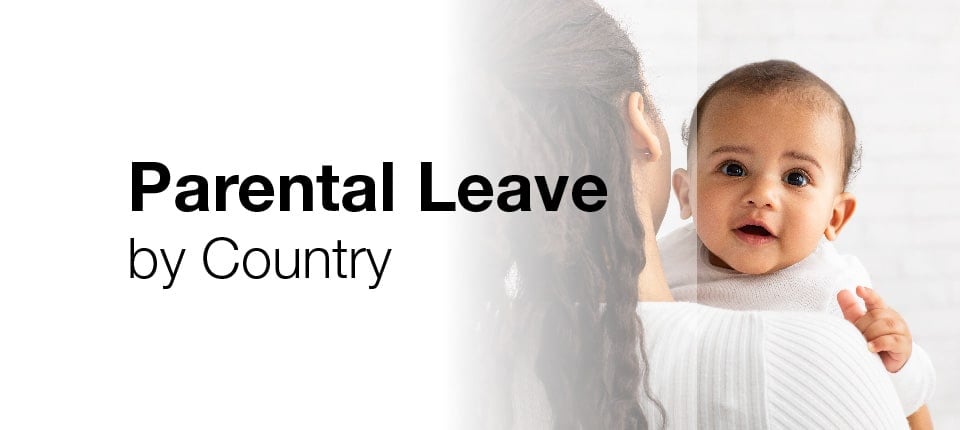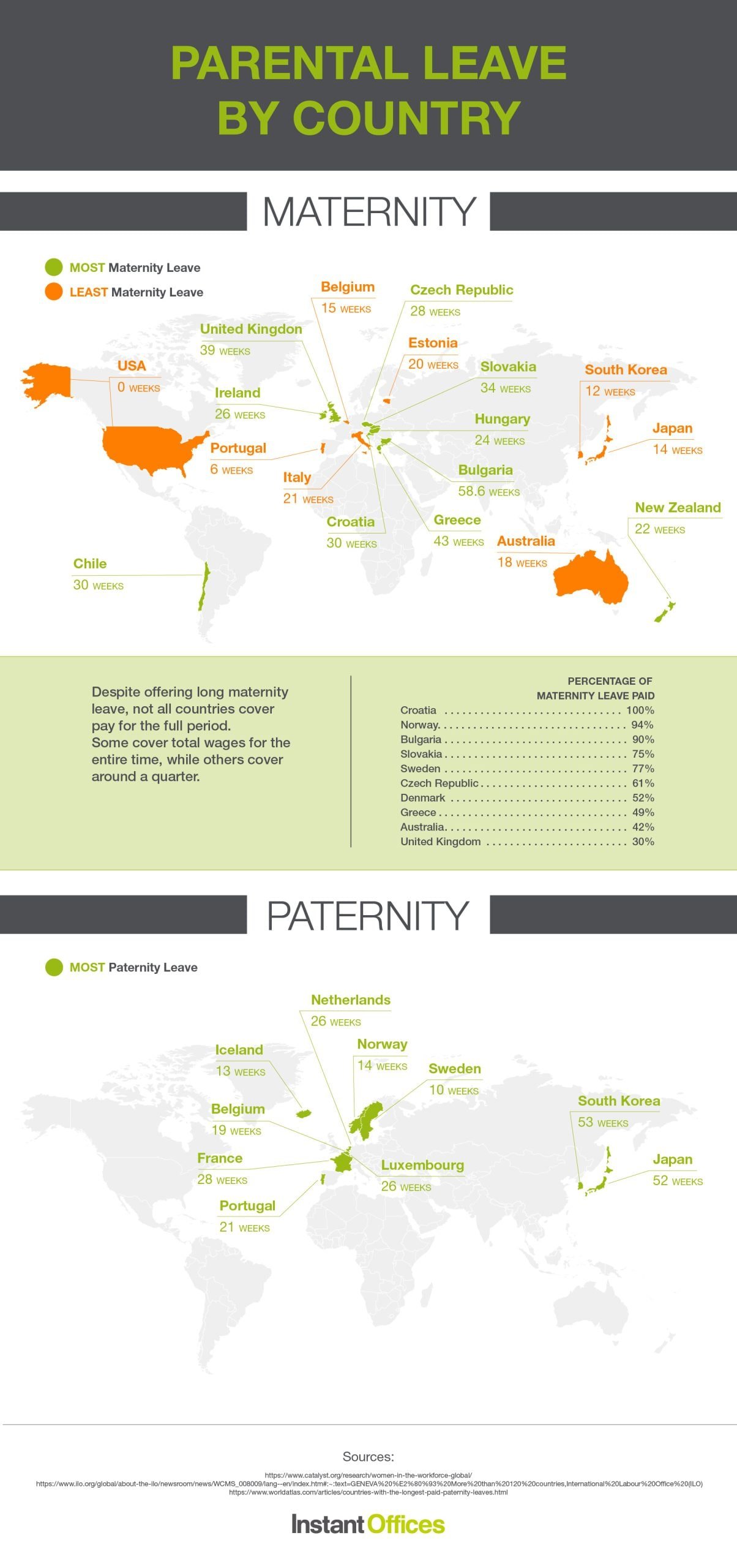A look at maternity and paternity leave around the world.
Women worldwide make up half of the total labour force but spend twice as much time on unpaid labour, like childcare and housework, than their male counterparts. While parental leave has increased for men worldwide and governments are attempting to address ongoing gender inequality, it’s still worth noting that maternity leave varies widely.
Types of leave available to new parents:
- Maternity leave: available to mothers for birth or adoption
- Paternity leave: available to fathers around the time of birth or adoption
- Parental leave: typically taken after birth or adoption and, in some countries, allocated to either mothers or fathers
Countries with the Most Maternity Leave
As of 2022, 8 of the 10 countries offering the most paid maternity leave are in Europe, with Bulgaria offering more than a year of paid leave for new mothers.
| Country | Weeks of Paid Maternity Leave |
|---|---|
| Bulgaria | 58.6 |
| Greece | 43 |
| United Kingdom | 39 |
| Slovakia | 34 |
| Croatia | 30 |
| Chile | 30 |
| Czech Republic | 28 |
| Ireland | 26 |
| Hungary | 24 |
| New Zealand | 22 |
Although many countries offer more time off, the salary percentage paid during the covered period varies widely. Some countries cover a new mum’s total wages, while others pay as little as one quarter.
| Country | Percentage of Maternity Leave Paid |
|---|---|
| Croatia | 100% |
| Norway | 94% |
| Bulgaria | 90% |
| Slovakia | 75% |
| Sweden | 77% |
| Czech Republic | 61% |
| Denmark | 52% |
| Greece | 49% |
| Australia | 42% |
| UK | 30% |
Countries with the Least Maternity Leave
In the US, 30% of women and 28% of men say paid leave is their most valued benefit at work. And while some states, like California and New York, have state-mandated paid leave in place, employers in the United States are not required to give paid maternity or parental leave as a national mandate.
If you’re an expecting mother living in the US, you can claim maternity leave through a government scheme called the Family and Medical Leave Act (FMLA), which includes 12 weeks of unpaid, job-protected leave for a newborn or adopted child and is only applied if you work with a certain number of employees and within a specific type of company.
A few European and APAC countries also offer very little maternity leave.
| Country | Weeks Paid |
|---|---|
| USA | 0 |
| Portugal | 6 |
| South Korea | 12 |
| Japan | 14 |
| Belgium | 15 |
| Australia | 18 |
| Estonia | 20 |
| Italy | 21 |
Promoting Gender Equality with Improved Paternity Leave
Key to promoting gender equality in the workplace is the provision of better parental leave for mothers and fathers. New mothers are offered leave in around 185 countries, while parental leave is only offered in 103.
In Europe, a directive on Work-Life Balance for Parents and Caregivers announced that all member states would be required to offer a minimum of 10 days of paid paternity leave to all fathers.
In some APAC countries, like Singapore, eligible working fathers can take paid leave of two weeks at any time from birth until the child’s first birthday. The pay is capped at $2,500 per week, or a total of $5,000.
Fathers in Hong Kong receive a minimum of five days of statutory paternity leave. As low as it may seem, this number has increased since January 2015, when fathers were allowed a minimum of three days. While paternity leave is a legal requirement, male employees can take a maximum leave of 14 days under the following criteria:
- Must be the child’s father
- Must have worked under a continuous contract of at least 40 weeks
- Must have evidence of a full birth certificate
In neighbouring Japan, the government aims to promote greater awareness of paternity leave for male employees. As of 1st October 2022, male employees will be entitled to four weeks of holiday within eight weeks of their child’s birth. Payments will be given via social security at the same rate as maternity leave (67%).
Countries with the Most Paternity Leave
| Country | Weeks of Paid Paternity Leave |
|---|---|
| South Korea | 53 |
| Japan | 52 |
| France | 28 |
| Luxembourg | 26 |
| Netherlands | 26 |
| Portugal | 21 |
| Belgium | 19 |
| Norway | 14 |
| Iceland | 13 |
| Sweden | 10 |
Countries with the Least Paternity Leave
Typically, you’d expect lower GDP countries to be offering the least paid paternity leave. However, countries such as Tajikistan, Uzbekistan and Mongolia offer a minimum of 14 weeks of paid paternity leave. Meanwhile, Brazil and the Democratic Republic of Congo are two developing nations with a high infant population that offer a maximum of three weeks.
According to an OECD data report, developing economies such as India hope to improve parental leave options for both mothers and fathers.
The option to take parental leave in the USA for many fathers can be difficult as new and expecting fathers are entitled to 12 weeks of unpaid leave. This goes for mothers, too as the decision on paid maternity leave is up to the employer and, in some cases, the state.
More Countries Offering Bereavement Leave
More countries are starting to follow the compassionate examples set by India, Taiwan, and the Philippines by offering bereavement leave to grieving parents after a miscarriage or stillbirth.
Since 1961, India has granted six weeks of fully paid leave for women who experience a miscarriage. The Philippines allows up to 60 days of paid leave after miscarriage. Other APAC nations with similar policies include Mauritius, Taiwan, and Singapore.
New Zealand recently followed suit, passing the Bereavement Leave for Miscarriage Bill, which allows three days of paid leave for parents experiencing pregnancy loss.
Hopefully, we will start seeing this type of leave become normalised as more policymakers realise its importance. There is still a lot of progress to be made here. For example, the UK workplace only allows women to take paid leave if they have a miscarriage or stillbirth after 24 weeks of pregnancy. In Australia, women can take unpaid leave only if they miscarry after 12 weeks of pregnancy.
Maternity Leave and the Gender Gap
Better family support policies will help improve women’s participation in the workforce and lessen the burden of unpaid labour on working mothers. Despite some progress in recent years, COVID-19 has caused significant disruptions in work-life balance, and women are now spending 15 hours more on unpaid work like caregiving every week compared to men, which increases the pay gap.
With more countries moving towards better equality around parental leave, more men are being encouraged to take time off after the birth of their child or after their partner’s maternity leave has ended. To promote this, couples are being offered more shared leave entitlements and more freedom around how they split their leave.
By encouraging a better work-life balance for women and men and flexible offices and remote working options, more countries and businesses are embracing the effort to support a more diverse workforce.
If you want to find out more office rental terms or just want to brush up on your office jargon we’ve created a useful Glossary of Flexible Office Space terms, whether it’s hybrid, hotdesking or flexi working you’ll find all the explanations you need.
Looking for Office Space?
We Operate in Some of the World’s Top Cities:
London, New York, San Francisco, Paris, Singapore, Hong Kong, Search more locations

